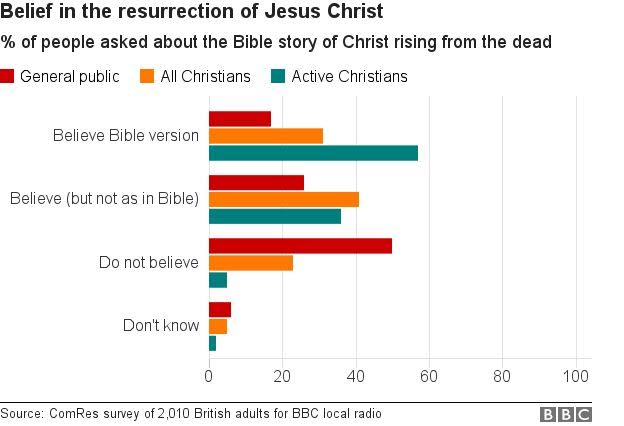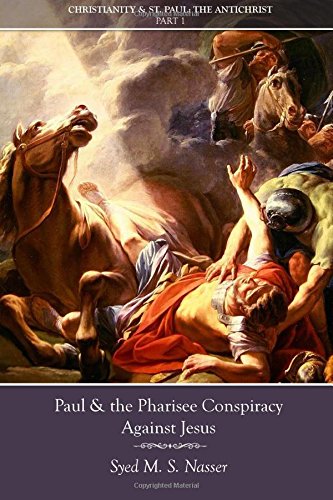A poll this year conducted by the BBC found that 40% of all Christians don’t believe in the Resurrection story as portrayed in the Bible, with 25% not believing in it at all. The result? More Christians don’t believe in the Biblical Resurrection story than do believe in it!

So how should sceptical Christians — who now seem to constitute the UK majority — understand the Resurrection narrative?
The swoon theory, first advocated and best elucidated by Mirza Ghulam Ahmad, in his book “Jesus in India” seems to be the explanation people are turning to. Ahmad simply applied the principle of Occam’s Razor to the Resurrection narrative and in doing so, radically re-interpreted the crucifixion events.
Ahmad asked a simple question: if you see someone walking around three days after you saw him undergoing execution, with the very wounds of his execution still fresh, asking for food, travelling in the dead of night, refusing to present himself to the authorities who sentenced him, what’s going to be your natural conclusion?
Is it more likely that: a) they died and came back to life; or b) they never died in the first place, and simply survived their ordeal?
Indeed, there is not a single example in human history of a dead person coming back to life, but there are many examples of individuals surviving botched execution attempts, making the latter far more likely.
To support his theory, Ahmad highlighted the fact that Jesus was only on the cross for some six hours, whereas it usually took people up to twenty-four hours to die by crucifixion; the thieves crucified with Jesus were still alive at the time when Jesus was presumed dead. This theory is made even more plausible with Ahmad’s observation that Jesus was a young fit man, giving him ample physiological reserves. Moreover, Jesus’ bones were not broken on the cross, unlike those of the two thieves with him.
Indeed, medical scrutiny of the crucifixion narrative indicates that Jesus was still alive at the time of being taken down: the spear lanced into his side, according to the Gospels, describe the “gushing out” of blood and water. Doctors have pointed out that blood does not “gush” out of a dead body, but a living one. The use of myrrh and aloes by Jesus’ doctor, Nicodemus, once taken down from the cross, point to his continued survival too. These are not, as argued by the Gospel writer, “embalming herbs” but healing herbs, used to this day to promote wound healing.
But if Jesus didn’t die on the cross and then ascend to heaven, where is he now? Ahmad argued that Jesus migrated East to seek the lost sheep of the House of Israel as he promised he would, and ultimately died there. In fact, Ahmad said he had discovered Jesus’ tomb in Kashmir, which has now managed to find its way on to the Lonely Planet travel guide!
So where did the Resurrection story come from, if it wasn’t true? That’s the subject of my new book, “Paul & the Pharisee Conspiracy Against Jesus.”
We must remember that the first person to write about the Resurrection as a literal resurrection from death, was St. Paul, long before any of the Gospels. Why did he do this?
I argue that St. Paul was not a follower of Jesus, but a hypocrite — the wolf in sheep’s clothing Jesus warned of. As a Pharisee persecutor of Jesus’ followers, he had failed to stem the tide of conversions to Jesus’ Judaism, especially after Jesus’ survival from crucifixion.
Paul thus changed his tactics. He infiltrated Jesus’ community and began to propagate doctrines amongst them through means of secretive epistles (Corinthians, Galatians, Romans) that would put off any orthodox Jews from accepting Jesus.
The principle method Paul utilised was to misrepresent Jesus’ survival of crucifixion, as death and resurrection. He then linked his new doctrines to Jesus’ alleged atoning death.
But how would alleging that Jesus died on the cross serve Paul’s Orthodox Jewish cause? Simple. Since the Old Testament teaches that one who dies on wood is “accursed of God,” no orthodox Jew in their right mind would accept religious doctrines with an accursed Messiah at their centre, especially those that would appear to run contrary to fundamental Jewish doctrines of God’s unity and the necessity of divine law, as the Trinity and New Covenant do, respectively.
Through this tactic, Paul sought to create clear blue water between orthodox Jews and Jesus’ Jews, so that no orthodox Jew would bridge the gap. What Paul didn’t anticipate however, was how Jesus’ Jews would react.
Indeed, I highlight something entirely ignored in Biblical studies — that it was Jesus’ Jewish followers from Galatia, not orthodox Jews, who rioted in the Temple in Acts 21 on seeing Paul. It was they who had him arrested by the Romans, citing their reason that “this is the man who teaches all men everywhere against our people and against our Law and against this place.”
My book asks a simple question: why were Jesus’ followers, twenty-five years after the crucifixion, mobbing Paul as a heretic for preaching what now constitute modern Christian doctrines? If they still believed in the necessity of Jewish law for salvation, then where does Jesus’ atoning death and resurrection fit in? The inevitable conclusion is that modern Christian doctrines didn’t come from Jesus.
The clincher however, is in the extra-Biblical sources. By carefully reading 1st century Jewish historian Josephus, we can see that Paul reverted to being a Pharisee after his imprisonment in Rome.
Ahmad’s re-interpretation of the crucifixion events have dramatic implications for Christian theology. If Jesus survived the crucifixion ordeal, then he didn’t die for anyone’s sins. There was no atonement, and no resurrection. The doctrine of the New Covenant, that salvation is obtained through faith in Jesus’ death rather than through works under the law, is untrue. Further, if Paul is shown to have concocted major Christian doctrines to misrepresent Jesus, then it means that Christians would need to radically review how they understand the message of Christ.
You can buy Paul and the Pharisee Conspiracy Against Jesus here.
By Syed Nasser & Tahir Nasser















Too bad you wanna sell a book so desperately that you lie.
Too bad you wanna prevent any view on religion different to yours from gaining ground so bad that you feel you just have to leave a cheap comment. Read the book and then share some, hopefully, constructive comments on it.
The major pathophysiologic effect of crucifixion was an interference with normal respirations. Accordingly, death resulted primarily from hypovolemic shock and exhaustion asphyxia. Jesus’ death was ensured by the thrust of a soldier’s spear into his side. Modern medical interpretation of the historical evidence indicates that Jesus was dead when taken down from the cross.
(JAMA 1986;255:1455-1463)
The injury to the chest with a spear can result in pleural effusion but the blood congeals in a dead man with poor flow with blood clots and pleural fluid. It is most probable that the infantry spear came to the rescue of Jesus Christ when it pierced the pericardial cavity and revived the encaged heart as ‘blood and water gushed out’. It is only in a beating heart of a living person that blood gushes out.
Read this article written by a Cardiologist:
https://www.reviewofreligions.org/11445/jesus-christ-did-not-die-on-the-cross-a-cardiologists-perspective-2/
Too bad Muslims only read the crucixtion account written by non eyewitnesses 600 years after the event ,
Too bad Christians don’t know who the “eye-witnesses” are…
There were more than 500 witnesses who testified to the resurrection. In 1 Corinthians 15:3-6, Paul writes, “For I delivered to you as of first importance what I also received, that Christ died for our sins according to the Scriptures, and that He was buried, and that He was raised on the third day according to the Scriptures, and that He appeared to Cephas, then to the twelve. After that, He appeared to more than five hundred brethren at one time, most of whom remain until now, but some have fallen asleep.”
If you see a man after his scheduled execution walking around, the inference should be that he survived, not that he died and came back to life.
Which eye-witness accounts do you refer to? None of the writers of the gospels were present on the spot to stand as eye-witness. Nor were any of the disciples there at the crucifixion, as the Bible tells us “And they all forsook him, and fled” (Mark 14:50)
Can you provide me 1 account out of the “more then over 500” eye-witnesses who saw the crucifixion?
Muslims don’t believe the Gospel or believe that Jesus Christ is the Son of God and did die that horrible death to save His people from their sins but WAS raised from the dead because He is the Son of God,and He had completed the work He had been sent to earth to do by Almighty God,His Heavenly Father and DID ascend to Heaven and will return again in Glory to take His Faithful home!
1
Modern medical interpretation of the historical evidence indicates that Jesus was dead when taken down from the cross.
(JAMA 1986;255:1455-1463),DOES TAHIR NASSER READ MEDICAL JOURNALS ?
Who witnessed the crucifixion of Jesus?
Matthew and Mark, who speak of “many women” present at the crucifixion, mention three individually at the death of Jesus and two at his burial. Matthew describes the third individual present at the death as the mother of the sons of Zebedee, without naming her. Mark’s third individual is called Salome.
Why do you think that these books were written by apostles and companions of the apostles?
Do you think that they were written by eyewitnesses and companions of eyewitnesses? lol
An eyewitness could be trusted to relate the truth of what actually happened in Jesus’ life. But the reality is that eyewitnesses cannot be trusted to give historically accurate accounts. They never could be trusted and can’t be trusted still. If eyewitnesses always gave historically accurate accounts, we would have no need for law courts. If we needed to find out what actually happened when a crime was committed, we could just ask someone. Real-life legal cases require multiple eyewitnesses, because eyewitnesses’ testimonies differ. If two eyewitnesses in a court of law were to differ as much as Matthew and John, imagine how hard it would be to reach a judgment.
A further reality is that all the Gospels were written anonymously, and none of the writers claims to be an eyewitness. Names are attached to the titles of the Gospels (“the Gospel according to Matthew”), but these titles are later additions to the Gospels, provided by editors and scribes to inform readers who the editors thought were the authorities behind the different versions. That the titles are not original to the Gospels themselves should be clear upon some simple reflection. Whoever wrote Matthew did not call it “The Gospel according to Matthew.” The persons who gave it that title are telling you who, in their opinion, wrote it. Authors never title their books “according to.”
5
4.5
No, Occam’s Razor does NOT validate any of Christianity’s supernatural claims. So why do so many Christian apologists continue to misuse this principle?
https://lutherwasnotbornagaincom.wordpress.com/2023/05/09/do-christian-apologists-misuse-occams-razor/